What are Blood Collection Tubes?
- Designed specifically for safe and effective collecting, storage, and transportation of blood samples for diagnostic testing and research, blood collection tubes are used in
- Usually constructed of glass or plastic, they have a pre-evacuated vacuum that, upon needle insertion, pulls a specified volume of blood into the tube.
- To match different laboratory tests, the containers are color-coded to show the kind of additive inside—anticoagulants (e.g., EDTA, heparin, sodium citrate), clot activators, or preservatives.
- Important for achieving accurate test findings, blood collecting tubes decrease contamination, lower the danger of hemolysis, and standardize sample quantities.
- Modern blood collecting tubes originated in the late 1940s when Joseph Kleiner developed the first vacuum tube system, subsequently sold commercially as the BD Vacutainer.
- Improvements like the use of plastic tubes and other additive compositions have throughout time improved the accuracy, safety, and simplicity of blood sample collecting.
- Maintaining the integrity of the specimens depends on the consistent sequence of the draw process avoiding cross-contamination of additives across tubes during multi-tube blood draws.
- Modern clinical diagnostics, research, and transfusion medicine all depend on blood collecting tubes, which help to accurately identify diseases, treat patients, and maintain public health generally.
Components of Blood Collection Tube
Components of Blood Collection Tubes:
- Tube Wall: Constructed from either glass (borosilicate or soda-lime) or plastic (polyethylene terephthalate, polyethylene, or polypropylene). Typically range from 50 to 150 mm in length and 10 to 20 mm in diameter. Provides structural integrity and protects the sample from external contaminants. Plastic tubes offer enhanced durability and a reduced risk of cross-contamination compared to glass.
- Rubber Stopper: Made from synthetic rubber, ensuring a secure seal to prevent leakage or contamination. The stopper’s color indicates the type of additive present in the tube, guiding healthcare professionals in selecting the appropriate tube for specific tests.
- Additives: Depending on the intended analysis, tubes may contain additives such as anticoagulants (e.g., EDTA, heparin, sodium citrate), clot activators, or preservatives. These substances either prevent blood from clotting or facilitate clot formation, aligning with the requirements of specific tests.
- Stopper Lubricant: Applied to the stopper to ensure smooth insertion and removal, maintaining the tube’s airtight seal and preventing sample contamination.
- Tube Surfactant: Coats the interior of the tube to prevent blood cells from adhering to the walls, ensuring a homogeneous sample and accurate test results.

Order of Draw in Blood Collection Tube
- During venipuncture, draw follows a consistent protocol meant to prevent additive cross-contamination across tubes and guarantee proper test findings.
- Initially gathered to preserve sterility and avoid contaminating microbiological materials, blood culture tubes
- Usually blue top tubes containing sodium citrate, coagulation tubes are pulled next to maintain correct clotting factor activity.
- Serum tubes follow, with either gel separators or clot activators, as their additions are less likely to contaminate later samples.
- Drawn after serum tubes to reduce interference with coagulation tests, Heparin tubes (green top) used for plasma chemistry tests
- For hematology, EDTA tubes (lavender top) are drawn next as their powerful calcium-chelating effects can compromise coagulation tests if drawn sooner.
- Drawn last, glycolysis inhibitor tubes (gray top) are gray as the additives—sodium fluoride, potassium oxalate—need quick mixing to stop metabolic changes in the sample.
- Maintaining specimen integrity and guaranteeing accurate laboratory results depend on following this sequence of draw, advised by standards like those of the Clinical and Laboratory Standards Institute (CLSI).
Step by Step Guide to the Order of Draw
- Before starting venipuncture, line all necessary blood collecting tubes in the specified sequence of draw and check that every tube is properly labeled.
- Starting with the blood culture tube, usually taken first to guarantee the sample stays clean and free from additional contamination
- Then go to gather the coagulation tube—typically a blue top tube filled with sodium citrate—which is essential for a precise measurement of clotting components.
- Next, draw the serum tube—often distinguished by a red or gold top—containing clot activators (with or without gel separators), therefore enabling serum separation for different biochemical analyses.
- After serum tubes, gather the heparin tube; these green top tubes prepare plasma for chemical studies using heparin as an anticoagulant without affecting coagulation tests.
- Draw the EDTA tube next, usually a lavender or purple tip tube, utilized for hematology research as its high calcium-chelating qualities might change coagulation findings if drawn early on.
- To stop metabolic changes in glucose levels during storage, lastly gather the glycolysis inhibitor tube—typically a gray top tube filled with chemicals like sodium fluoride and potassium oxalate.
- Following exactly manufacturer specifications and CLSI rules, gently invert each tube the recommended number of times after collecting to guarantee complete mixing of the additives with the blood.
- Verify that every sample is correctly labeled and kept under suitable conditions to maintain sample integrity for next laboratory examination.
Color of the Cap and Its Purpose
As discussed previously, the colour of the tube’s cap indicates its function and anticoagulant content. The colour of the tubes also impacts the required clotting time and the number of inversions required once blood is deposited into the tubes. Standard laboratory procedures call for the utilisation of yellow, pink, blue, lavender/purple, red, green, and light blue colour tubes.
The colour of the anticoagulant tube and its application are as follows:
1. Marble or Gold (SST) (Plastic tubes with clot activator and gel for serum separation)
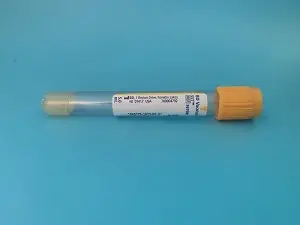
What are Clot Activator Plastic Tubes?
Clot activator plastic tubes are a type of blood collection device designed to enhance the accuracy and reliability of blood tests. They are made of high-quality plastic material that is safe for human use and comes with a built-in clot activator and gel that facilitates the separation of serum from the blood cells. The clot activator helps the blood to form clots quickly, reducing the risk of contamination and ensuring the accuracy of the test results.
How Do Clot Activator Plastic Tubes Work?
The working principle of clot activator plastic tubes is straightforward. The blood is collected in the tube, which contains the clot activator and gel. After the collection, the tube is inverted five times to mix the clot activator with the blood. This process triggers the clotting process, and the gel helps to separate the serum from the blood cells. The serum can then be tested for various markers, and the results are compared against the normal range to diagnose any underlying medical conditions.
Clotting Time Required
One of the key benefits of using clot activator plastic tubes is the reduced clotting time. It takes only 30 minutes for the blood to form clots in the tube, compared to the traditional methods that can take up to several hours. The quick clotting time helps to minimize the risk of contamination and preserve the integrity of the blood sample, leading to more accurate test results.
Commonly Associated Tests
Clot activator plastic tubes are commonly used in a wide range of tests, including chemistry profiles, electrolytes, lipid panel, hepatic panel, hepatitis panel, thyroid studies, iron studies, cancer markers, lithium, alcohol, vitamin B12, vitamin D, hormone studies, cardiac markers, lidocaine, folate, therapeutic drugs (except carbamazepine), tricyclic antidepressants, salicylate, and homocysteine (ON ICE). These tests help diagnose various medical conditions, monitor the effectiveness of treatments, and assess the overall health of an individual.
In conclusion, the use of clot activator plastic tubes in blood tests has revolutionized the medical industry, providing faster and more accurate results. The tubes are easy to use, and their quick clotting time minimizes the risk of contamination, preserving the integrity of the blood sample. The wide range of tests that can be performed with these tubes makes them a versatile solution for medical diagnoses and treatments. If you’re looking for a reliable and accurate blood collection method, consider using clot activator plastic tubes.
2. Plain Red (Silicone coated made of glass)
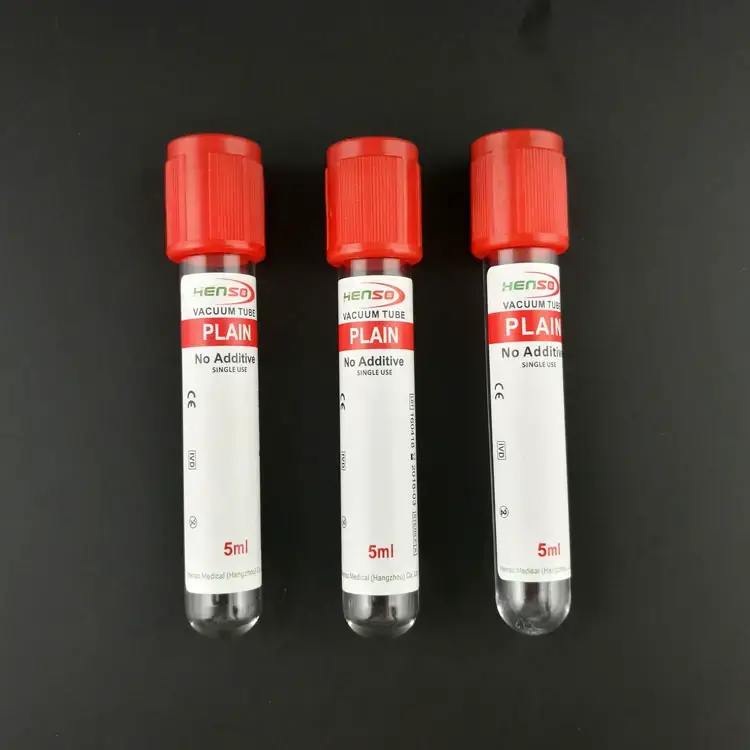
Advantages of Silicone Coated Glass
One of the primary benefits of silicone coated glass is that it eliminates the need for tube inversions. This not only saves time but also reduces the risk of sample contamination and the chance of errors in results. In addition, the silicone coating provides a smooth and uniform surface that prevents sample buildup and makes cleaning easy.
Reduced Clotting Time
Another major advantage of silicone coated glass is that it reduces the clotting time required for tests. In traditional glass tubes, clotting time can range anywhere from 30 minutes to two hours, depending on the type of sample being tested. With silicone coated glass, however, the clotting time is reduced to just 60 minutes, making it one of the fastest and most efficient testing methods available.
A Wide Range of Tests
Silicone coated glass can be used for a wide range of tests, including the Rheumatoid factor (RF) test, RPR (rapid plasma reagin test), uric acid, PTH (parathyroid hormone), insulin, prealbumin, magnesium, BhCG (beta-human chorionic gonadotropin) test, FT3/FT4 (free triiodothyronine and free thyroxine), digoxin, amylase, lipase, cortisol, CRP (C-reactive protein) test, and C-peptide. This versatility makes silicone coated glass an essential tool in any medical testing laboratory.
In conclusion, silicone coated glass has revolutionized the world of medical testing by providing faster and more accurate results. Its ability to eliminate tube inversions, reduce clotting time, and be used for a wide range of tests makes it a must-have tool for any laboratory. If you’re looking to improve the efficiency and accuracy of your testing processes, look no further than silicone coated glass.
3. Green (Lithium heparin (light green tube tubes containing lithium heparin and gel for plasma separation) is the additive.)

The Role of Lithium Heparin as an Anticoagulant
Lithium heparin is a commonly used anticoagulant in the medical field, especially in the collection of blood samples for diagnostic tests. It is added to blood samples to prevent coagulation and preserve the integrity of the blood cells. Lithium heparin is stored in light green tubes and is mixed with the blood sample by performing eight tube inversions.
No Clotting Time Required
One of the advantages of using lithium heparin as an anticoagulant is that it does not require a clotting time. This means that the blood sample can be processed immediately after collection, reducing the chances of inaccurate results due to the formation of clots.
General Chemistry Requests and Associated Tests
Green and light green vacutainer tubes containing lithium heparin are preferable for all STAT general chemistry requests. These tests include chemistry profiles, ionized calcium, lipid panel, hepatic panel, cardiac markers, rheumatoid factor (RF) test, ammonia (ON ICE), and therapeutic drugs (except for VANC and lithium). The light green tube is also used for the BhCG Quant test.
In conclusion, the use of lithium heparin as an anticoagulant and the proper mixing of the anticoagulant with the blood sample through tube inversions are critical in ensuring accurate diagnostic test results. By choosing the right anticoagulant and following proper collection techniques, healthcare providers can maximize the accuracy of their diagnostic tests and provide patients with the best possible care.
4. Gray (Sodium Fluoride/Potassium Oxalate)
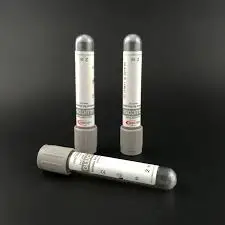
The Importance of Additives in Blood Sampling
Additives play a vital role in blood sample testing, as they help to preserve the integrity of the sample and prevent degradation. Sodium fluoride and potassium oxalate are commonly used additives, as they effectively inhibit glycolysis and prevent the breakdown of glucose. This ensures that accurate glucose levels can be obtained, even when drawing blood samples from a long distance from the hospital.
Eight Tube Inversions: The Key to Proper Mixing
In order to ensure proper mixing of additives with blood, 8 tube inversions are recommended. This simple step helps to distribute the additives evenly throughout the sample, providing consistent results. It’s important to note that this process should be performed carefully, as over-agitation can cause hemolysis, leading to inaccurate results.
No Clotting
Time Required An added advantage of using sodium fluoride and potassium oxalate as additives is that they do not require a clotting time. This eliminates the need for waiting for the blood to clot, allowing for quicker results. This is particularly important in emergency situations, where prompt diagnosis and treatment are vital.
Choosing the Right Tube for Specific Tests
When it comes to blood sample testing, it’s essential to choose the right tube for the specific test being performed. Gray top tubes are often used when checking glucose levels, as they preserve glucose and are particularly useful for samples drawn a long distance from the hospital. On the other hand, lactic acid testing is best performed using ON ICE tubes, which helps to preserve the integrity of the sample.
In conclusion, the proper use of additives, 8 tube inversions, and appropriate tube selection are all crucial elements of obtaining accurate blood sample results. By understanding the significance of these factors, healthcare providers can ensure the best possible outcomes for their patients. The combination of sodium fluoride and potassium oxalate as additives, 8 tube inversions, and the right tube selection can provide consistent and accurate results, making a difference in the diagnosis and treatment of medical conditions.
5. Purple/Lavender (Spray-coated K2 EDTA added in a plastic tube. So, also called as EDTA tube.)

Accurate results in blood tests are critical in diagnosing and treating medical conditions. To achieve these results, it is necessary to mix the anticoagulant properly with the blood and choose the right tube for the test. In this article, we will examine the benefits of using spray-coated K2 EDTA, the significance of 8 tube inversions, and the impact of tube selection on test accuracy.
The Advantages of Spray-Coated K2 EDTA Anticoagulant
The anticoagulant used in blood tests can greatly impact the accuracy of results. Spray-coated K2 EDTA is a commonly used anticoagulant due to its ability to effectively preserve blood samples and prevent coagulation. This ensures that the sample remains stable, allowing for more precise results.
Eight Tube Inversions for Optimal Mixing
Eight tube inversions are required to ensure that the anticoagulant is mixed evenly with the blood. This process helps to distribute the anticoagulant throughout the sample, leading to consistent results. It is important to perform the inversions carefully to avoid hemolysis and ensure accurate results.
No Clotting Time Necessary
The use of spray-coated K2 EDTA as an anticoagulant has the added advantage of eliminating the need for clotting time. This allows for quicker results, which can be crucial in emergency situations.
Choosing the Right EDTA Tube for Specific Tests
The type of tube used in a blood test can greatly impact the accuracy of results. EDTA tubes, also known as plastic tubes, are specifically designed for tests such as CBC (complete blood count) and PLT count, H&H (hemoglobin and hematocrit), SED rate (eosinophil sedimentation rate), BNP (B-type natriuretic peptide) test, HgbA1C, Cyclosporin, Sickle cell, RETIC (reticulocyte count), Path Review, Intra op PTH, Vancomycin, HIV, Direct Coombs, RBC Folate, PROGRAF, and CD3/CD4. These tubes ensure the stability of the sample and allow for accurate results in these tests.
In conclusion, the proper mixing of anticoagulants and the appropriate selection of tubes are essential in obtaining accurate results in blood tests. The use of spray-coated K2 EDTA anticoagulant, 8 tube inversions, and EDTA tubes can provide consistent and precise results, helping healthcare providers to make informed diagnoses and treatment decisions. By understanding the importance of these factors, we can ensure the best possible outcomes for patients.
6. Pink (Spray-coated K2 EDTA added in plastic tubes)
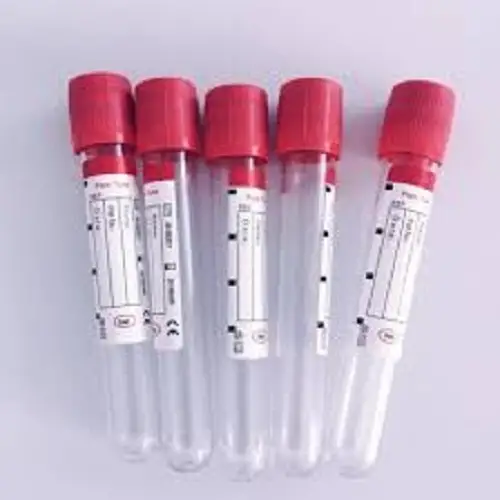
The Advantages of Spray-Coated K2 EDTA Anticoagulants
Anticoagulants play a critical role in preserving the stability of blood samples and preventing clotting. Spray-coated K2 EDTA anticoagulants are a popular choice due to their ability to maintain the integrity of the sample, leading to more precise test results.
Eight Tube Inversions to Prevent Clotting
Eight tube inversions are necessary to ensure proper mixing of the anticoagulant with the blood. This helps to distribute the anticoagulant evenly and prevent clotting, leading to consistent results. Careful inversions are crucial in avoiding hemolysis and ensuring accurate results.
No Clotting Time Required
The use of spray-coated K2 EDTA anticoagulants eliminates the need for a clotting time, providing quicker results. This can be particularly beneficial in emergency situations.
EDTA Tubes for Accurate Blood Typing and Screening Tests
EDTA tubes, also known as plastic tubes, are designed for specific blood tests, including blood typing and RH, blood typing and screening, antibody screen, crossmatch, and RHOGAM workup. These tubes preserve the stability of the sample, allowing for more accurate results in these tests.
In conclusion, the proper mixing of anticoagulants and the selection of the right tube play a critical role in obtaining accurate results in blood tests. The use of spray-coated K2 EDTA anticoagulants in plastic tubes, 8 tube inversions, and EDTA tubes can provide consistent and precise results, supporting healthcare providers in making informed diagnoses and treatment decisions. Understanding the importance of these factors is key to ensuring the best possible outcomes for patients.
7. Blue (Buffered sodium citrate 0.1-5 M (3.2%) glass and 0.109 M (3.2%) plastic. It is also called as PT tube)
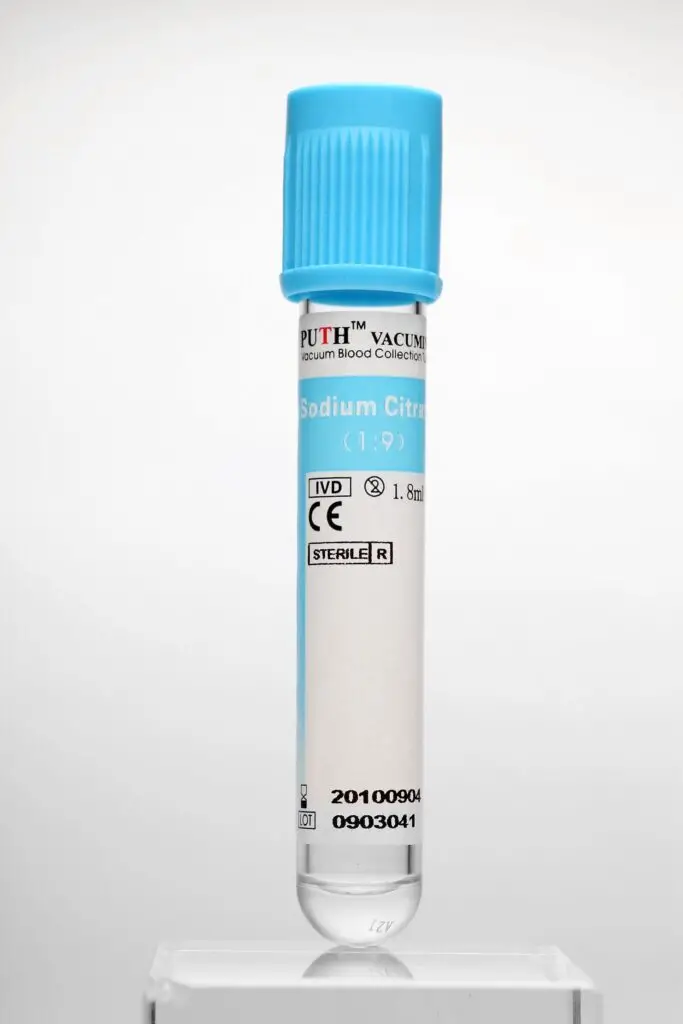
Coagulation testing plays a vital role in the diagnosis and treatment of various medical conditions, including deep vein thrombosis, pulmonary embolism, and bleeding disorders. The choice of anticoagulant and tube can significantly impact the accuracy of test results. In this article, we will examine the benefits of using buffered sodium citrate anticoagulants in PT tubes, the importance of proper mixing, and the role of these tubes in commonly associated tests.
The Advantages of Buffered Sodium Citrate Anticoagulants
Buffered sodium citrate anticoagulants are widely used in coagulation testing due to their ability to preserve the stability of blood samples and prevent clotting. The buffered formula provides a consistent pH balance, leading to more accurate test results.
Proper Mixing with 3-4 Tube Inversions
Proper mixing of the anticoagulant with the blood is essential for accurate test results. Three to four tube inversions are recommended to ensure the anticoagulant is evenly distributed and to prevent clotting.
No Clotting Time Required
The use of buffered sodium citrate anticoagulants eliminates the need for a clotting time, providing quicker results. This is especially beneficial in emergency situations.
PT Tubes for Accurate Coagulation Testing
PT tubes, also known as glass or plastic tubes, are designed specifically for coagulation testing, including PT/INR tests, PTT tests, fibrinogen, d’dimer, and special coag and factor assays. These tubes preserve the stability of the sample and provide consistent and accurate results.
In conclusion, the proper mixing of anticoagulants and the selection of the right tube play a crucial role in obtaining accurate results in coagulation testing. The use of buffered sodium citrate anticoagulants in PT tubes, 3-4 tube inversions, and the avoidance of a clotting time can ensure precise results and support healthcare providers in making informed diagnoses and treatment decisions. Understanding the importance of these factors is essential for ensuring the best possible outcomes for patients.
8. Royal Blue (Plastic tubes is sprayed with K2 EDTA. K2 EDTA increases the MCV (mean corpuscular volume) of RBC in higher concentrations)
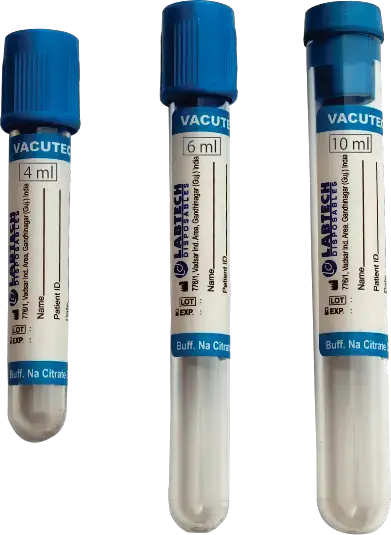
Toxicology testing is a crucial aspect of diagnosing and treating patients with potential metal exposure. The use of the right anticoagulant during the blood collection process can greatly affect the accuracy of test results. The additive of choice for toxicology testing is K2 EDTA, which is sprayed onto plastic tubes to ensure proper mixing of the anticoagulant with the blood.
Why K2 EDTA is Ideal for Toxicology Testing
K2 EDTA is an anticoagulant that increases the MCV (mean corpuscular volume) of RBC in higher concentrations, making it the preferred additive for toxicology testing. This anticoagulant ensures that the blood remains in its liquid form, allowing for the accurate determination of trace amounts of metals such as aluminum, cadmium, copper, lead, mercury, selenium, and zinc.
Tube Inversion for Optimal Mixing
During the blood collection process, 8 tube inversions are required to ensure that the K2 EDTA anticoagulant is properly mixed with the blood. This is essential to obtain accurate test results and avoid any potential contamination of the sample.
No Clotting Time Required
Another advantage of using K2 EDTA is that no clotting time is required. This speeds up the blood collection process and allows for quicker results.
Commonly Associated Tests
The use of K2 EDTA additive is recommended for toxicology testing to accurately determine trace amounts of metals. This type of testing is typically performed in a clinical laboratory setting.
Different Types of Tubes and Their Associated Tests
It is important to note that other types of tubes, such as the Gold Top (SST-Serum Separator Tube) and Plain Red Top Tube, should be mixed 5-6 times because they contain a clot activator. However, the Green Top (PST-Plasma Separator Tube) is the preferred choice if listed.
In conclusion, the use of K2 EDTA additive in plastic tubes for toxicology testing is the recommended method for accurate and efficient results. The proper mixing of the anticoagulant with the blood through 8 tube inversions and the lack of required clotting time make K2 EDTA an ideal choice for diagnosing and treating patients with potential metal exposure.
Uses of Blood Collection Tubes
- Blood samples for a variety of laboratory diagnostic tests—including biochemical, hematological, and immunological assays—are gathered and kept using blood collecting tubes.
- Using certain additives, such anticoagulants or clot activators, they create a regulated environment that helps to maintain the integrity of the material for intended analysis.
- Through centrifugation—which is crucial for reliable test findings in clinical chemistry and coagulation studies—they help separate blood components like serum and plasma.
- Maintaining sterile conditions helps them to facilitate microbiological testing, therefore allowing accurate blood culture techniques for the detection of infections.
- Research environments for biomarker analysis, pharmacokinetic investigations, and clinical trials need for their use to guarantee uniform sample quality and repeatability.
- By standardizing the sample amount for different assays, they assist to reduce preanalytical mistakes such hemolysis and contamination.
Advantages of Blood Collection Tubes
- Standardized sample quantities offered by blood collecting tubes through a pre-evacuated design guarantee precision and repeatability in test findings.
- Integrated compounds, like preservatives, clot activators, or anticoagulants, fit the specimen for particular diagnostic tests.
- The closed system reduces hemolysis and contamination, hence maintaining sample integrity.
- Color-coded stoppers help to correct tube arrangement and identification, therefore minimizing preanalytical mistakes.
- Their design lowers the need for several venipunctues, hence improving patient comfort and safety.
- The method reduces bloodborne pathogen exposure, therefore safeguarding patients as well as healthcare workers.
- Glass or plastic tubes’ sturdy, sterile design facilitates dependable long-term storage and effective laboratory processes.
Limitations of Blood Collection Tubes
- Over time, blood collecting tubes can lose vacuum pressure, which would cause insufficient blood draw if used past their expiration or incorrectly kept.
- Inadequate inversion of tubes following collection might result in insufficient additive mixing, generating clots or hemolysis compromising test accuracy.
- Some tests may be interfered with by chemical additions inside the tubes, therefore producing either erroneous or inconsistent laboratory findings.
- If the standardised sequence of draw is not carefully followed, cross-contamination of additives across tubes might result, therefore influencing the results of later tests.
- Variability in tube manufacturing standards and design across several vendors might cause variations in sample integrity and repeatability.
- These tubes, being single-use devices, add to medical waste and can be more expensive in busy clinical environments.
In summary
| Color of the Tube | Anticoagulant |
| Yellow, Pink, and Blue | Sodium polyanethole sulfonate (SPS) |
| Light Blue “citrate tube” | Sodium citrate (3.2%) |
| Red | No anticoagulant or additive inside the tube |
| Green | Heparin (sodium heparin, lithium heparin, or ammonium heparin) |
| Lavender/Purple “EDTA tubes” | Ethylene-diamine-tetra-acetic-acid |
| Gray | Potassium oxalate and sodium fluoride |
FAQ on Blood Collection Tubes
What are blood collection tubes used for?
Blood collection tubes are used to collect and transport blood samples for laboratory analysis.
How many types of blood collection tubes are there?
There are several types of blood collection tubes, including: plain (red-top), EDTA (purple-top), heparin (green-top), serum (yellow-top), and others.
What is the difference between red-top and yellow-top tubes?
Red-top tubes are used for serum chemistry tests and do not contain an anticoagulant. Yellow-top tubes contain an anticoagulant and are used for serum separations and blood bank tests.
What is the purpose of EDTA in purple-top tubes?
EDTA (ethylenediaminetetraacetic acid) is used in purple-top tubes as an anticoagulant to prevent blood from clotting during storage and transportation.
What is the difference between green-top and purple-top tubes?
Green-top tubes contain sodium heparin as an anticoagulant, while purple-top tubes contain EDTA. The type of anticoagulant used depends on the specific laboratory test being performed.
Can I use any tube for any test?
No, different tests require specific types of tubes. For example, some tests require plain (red-top) tubes, while others may require EDTA (purple-top) or heparin (green-top) tubes.
How long can blood samples be stored in collection tubes?
It depends on the type of tube and the storage conditions, but blood samples can typically be stored for up to 48 hours at room temperature in EDTA (purple-top) tubes and up to 72 hours in refrigerated heparin (green-top) tubes.
Is it okay to shake blood collection tubes?
No, blood collection tubes should not be shaken, as this can affect the results of some laboratory tests.
Can blood collection tubes be reused?
No, blood collection tubes are for single use only and should be discarded after a single use.
What is the proper order for drawing blood into different tubes?
The order of drawing blood into different tubes depends on the specific laboratory tests being performed, but it is important to follow the proper order to prevent contamination of the samples and ensure accurate test results.
- Text Highlighting: Select any text in the post content to highlight it
- Text Annotation: Select text and add comments with annotations
- Comment Management: Edit or delete your own comments
- Highlight Management: Remove your own highlights
How to use: Simply select any text in the post content above, and you'll see annotation options. Login here or create an account to get started.